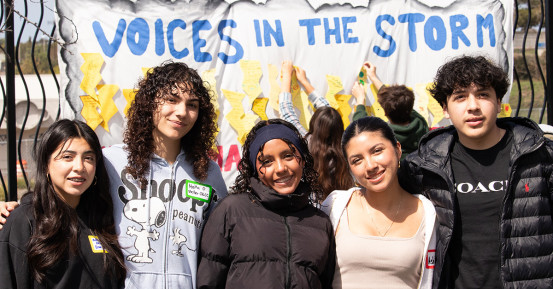Communities of the Heart
Investigation reveals how proper cellular interactions prevent cardiac calamity
Published Date
Story by:
Media contact:
Topics covered:
Share This:
Article Content
Humans are born with one heart, and Elie Farah, Ph.D., postdoctoral scholar at the University of California San Diego School of Medicine, says that one heart comes with pretty much all the muscle cells it’s going to have through an individual’s entire life. He added that cardiac muscle cells primarily grow after birth through a process called hypertrophy. “But they don’t regenerate in adults. They don’t grow back,” he added.
But Farah said the cells of the heart do form communities and have a surprisingly sophisticated form of biochemical communication. The heart’s finite cell census makes a full understanding of the communities of cardiac cells an important matter, as cellular miscommunication can lead to congenital cardiac birth defects as well as several varieties of heart disease in adults.
Farah is the lead author on a new study, recently published in Nature that underscores the importance of correct cellular communication. If the structures of the heart muscles don’t form correctly, it can lead to congenital heart disease, the most common birth defect. Several adult heart diseases also can develop. Farah said the left ventricle is a known problem area: “It pumps blood to your entire body and if the left ventricle fails, that’s heart failure.”
A common left-ventricle malady is hypertrophic cardiomyopathy, in which the walls of the left ventricle stiffen up and reduce the heart’s blood-pumping efficiency. Another set of adult conditions are valvulopathies, in which the valves of the heart don’t open or close properly. Many such problems stem from impaired cellular interaction among the communities and subcommunities of cells that make the heart function.
“You can actually think of the heart as like actual neighborhoods of people,” Farah explained. “If you put a group of neighborhoods together, you get a city.”
The neighborhoods that make up cardiac communities are organized into specific cardiac structures critical for heart function. They include the four cardiac chambers: left and right atria, and the left and right ventricles. The right atrium receives low-oxygen blood and pushes it to the right ventricle, which then pumps it to the lungs. The left atrium receives oxygen-rich blood from the lungs to pump it to the left ventricle, which propels it to the rest of the body.
Farah said each of these chambers require very specialized cells that produce the proteins necessary to perform those specific functions. They used two techniques to analyze the cell communities that make up the specific chambers of heart muscle. One is single-cell RNA sequencing, which allows profiling every single cell in the heart. The second is MERFISH, a single-molecule imaging process.
“We integrated those two techniques to define the communities and then interrogate the cell-cell interactions within them,” he said, getting insight into the expression and spatial location of 238 genes.
They gave special attention to the important left ventricle, finding what Farah described as a “layered organization.” As the team went through the layers, they found each layer was its own separate community. They began investigating the cell-cell interactions and discovered that the cells within the layers communicated with each other through signaling pathways.
Their investigation resulted in evidence that one such pathway — plexin semaphorin — may be involved in a process known as ventricular compaction, basically a smoothing and firming of the muscle in the ventricles during prenatal development.
“We found a single signaling pathway that may be involved in that, and defects in that pathway can lead to noncompaction, a potential cardiomyopathy that can affect many heart failure patients,” he said. They also discovered a very specialized cell type — potentially important for the development of the heart valves — that had not been previously characterized.
The UC San Diego investigation gives a fuller understanding of the cellular development in the heart and provides insight for the development of various new cardiac diagnostic strategies and therapies. For instance, Farah said that cultivating the right cells in vitro could create “a model of a developing heart in a dish” to be used for drug screening and regenerative therapies.
Co-authors, all from University of California San Diego are: Quan Zhu and Neil C. Chi (co-corresponding authors), Robert K. Hu, Colin Kern, Qingquan Zhang, Ting-Yu Lu, Qixuan Ma, Shaina Tran, Bo Zhang, Daniel Carlin, Alexander Monell, Andrew P. Blair, Zilu Wang, Jacqueline Eschbach, Bin Li, Eugin Destici, Bing Ren, Sylvia M. Evans and Shaochen Chen.
The study was funded, in part, by California Institute for Regenerative Medicine (GC1R-06673-B), and also was supported in part by grants from the NIH to B.R., S.M.E., Q. Zhu and N.C.C., the Chan Zuckerberg Initiative (2023-321230) to B.R., Q. Zhu and N.C.C., and the NSF (2135720) to S.C.
Competing interests: Bing Ren is a shareholder and consultant of Arima Genomics and co-founder of Epigenome Technologies. All other authors declare no conflicts of interest.
You May Also Like
Stay in the Know
Keep up with all the latest from UC San Diego. Subscribe to the newsletter today.




